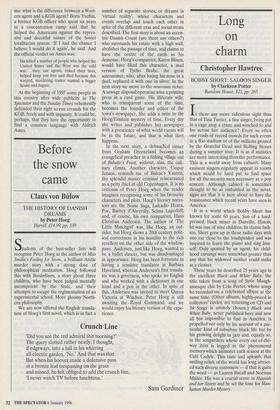Before the snow came
Claus von Billow
THE HISTORY OF DANISH DREAMS by Peter Hoeg Harvill, f14.99, pp. 339 Students of the best-seller lists will recognise Peter Hoeg as the author of Miss Smilla's Feeling for Snow, a brilliant Arctic murder story with a strong dose of philosophical meditation. Hoeg followed this with Borderliners, a story about three children, who have been judged mentally incompetent by the State, and their attempts to escape the regimentation of an experimental school. More gloomy North- ern philosophy.
We are now offered the English transla- tion of Hoeg's first novel, which is in fact a number of separate stories, or dreams in `virtual reality', whose characters and events overlap and touch each other in spite of the different eras and social strata described. The first story is about an eccen- tric Danish Count (are there any others?) who surrounds his estate with a high wall, abolishes the passage of time, and claims to have the centre of the earth as his demesne. Hoeg's compatriot, Karen Blixen, would have liked this character, a mad version of Tycho Brahe, the great astronomer, who, after losing his nose in a duel, replaced it with one in silver. In the next story we move to the nouveaux riches. A sewage disposal operative wins a printing press in a card game. His illiterate wife, who is transparent some of the time, becomes the founder and editor of the town's newspaper. She adds a twist to the Hoeg/Einstein mystery of time. Every day she writes and publishes her newspaper with a prescience of what world events will be in the future, and that is what then happens.
In the next story, a debauched sinner from Graham Greeneland becomes an evangelical preacher in a fishing village out of Babette's Feast, without, alas, the culi- nary climax. Another character, Caspar Jensen, reminds me of Balzac's Vautrin, the splendid master criminal reincarnated as a petty thief in old Copenhagen. It is no criticism of Peter Hoeg when the reader imagines recognising some of his favourite characters and plots. Hoeg's literary ances- tors are the Norse Saga, Lafcadio Hearn, Poe, Barbey d'Aurevilly, Selma Lagerloff, and, of course, his own compatriot, Hans Christian Andersen. The author of 'The Little Matchgirl' was, like Hoeg, an out- sider, but Hoeg shows a 20th-century polit- ical correctness in his hostility to the rich revellers on the other side of the window- pane. Andersen, just like Hoeg, wanted to be a ballet dancer, but was disadvantaged in appearance. Hoeg has been fortunate in having a sensitive translator in Barbara Haveland, whereas Andersen's first transla- tor was a governess, who spoke no English and who worked with a dictionary in one hand and a pen in the other. In spite of this, Andersen was invited to meet Queen Victoria at Windsor. Peter Hoeg is still awaiting the Royal Command, and we would enjoy his literary version of the expe- rience.


















































 Previous page
Previous page